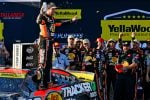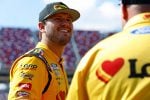Now, I don’t mind saying that if I make it to age 85, I will heartily approve if I look as youthful as former NASCAR competitor Harry Gant.
I’ve known Gant since his Late Model Sportsman days over 45 years ago. Gant was one of the most successful, and popular, drivers on the tour.
Pictures of him then weren’t much different than pictures of him now, if I may use a couple of examples taken just a couple of weeks ago.
His hair is still dark- maybe he uses some type of coloring, but hey, it’s working nicely – he’s still slim and his eyes and smile are just as bright as they always were.
Oh, sure, there are more facial lines, but that’s expected. And his outgoing personality hasn’t changed at all.
He earned the nickname “Handsome Harry” many years ago, and it applies today.
Gant got along well with the media, and they didn’t hesitate to target him in their coverage.
I once wrote a column poking fun at Gant’s canny ability to remain ageless in which I said the Taylorsville, N.C., native gained his youthful appearance through witchcraft.
He went into the mountains of North Carolina where he met up with an old hag named “Granny Weezie” who, according to those who knew her, was able to cast spells – good and bad.
Gant asked her to use her powers to make him eternally youthful in appearance. She made up a potion, he drank it and then she intoned as she waved her arms, “Young you shall be.” And, sure enough, that he remained.
I didn’t say it was a good column.
As good as he was in the Late Model Sportsman division, only a few thought he would advance to NASCAR Cup Series competition. After all, he was approaching 40 years old, and that was surely too old to attract owners’ attention.
But he did. In 1979, Gant, then 39, began driving for Race Hill Farms team owner Jack Beebe. The association lasted until early 1981 when Gant joined a new team, which would ultimately lead to his notoriety and success in Cup competition.
At Darlington Raceway in the spring of 1981, Gant made his debut with a new, much-anticipated organization that originated in Hollywood, of all places.
It was owned by the late stuntman and director Hal Needham, an extremely colorful character the likes of which NASCAR hadn’t seen.
And in addition to that, a co-owner was the late movie star Burt Reynolds, who added a significant amount of appeal and glamour.
Incidentally, Reynolds wasn’t an absentee owner. He attended several races and NASCAR functions.
The team was sponsored by U.S. Tobacco’s Skoal brand of smokeless tobacco and was marketed – brilliantly, by the way – as “The Skoal Bandit,” which became Gant’s moniker as soon as he joined the team.
After Needham’s opening stint in 1981 with driver Stanton Barrett, Gant took over at Darlington. His union showed great promise as it produced a second-place finish in its first outing.
But for a lengthy period of time, it seemed second place as going to be the best Gant could achieve. Throughout 1981 and into 1982, he and the team put together a string of 10 runner-up finishes without a single victory.
It didn’t go unnoticed. Gant received even more nicknames, ‘Runner-up Harry.” “Second Place Gant” and “The Almost There Man,” among others.
He got to be the brunt of comic stories. One of them was the tale of Gant and The Barber.
“Harry walked into a small-town barber shop,” the story went. “It had only one chair. The chair was empty. The barber looked at Harry, smiled, pointed and said, ‘Have a seat over there. You’re second.’”
The streak ended at Martinsville Speedway on April 25, 1982. Gant won the race easily by a lap over Butch Lindley.
Without a doubt, it was a vastly popular victory. The crowd of 36,500 (a sellout in the days before speedway expansion) was on its feet and cheered Gant louder on every closing lap.
Gant’s crew chief, the late Travis Carter, one of the most personable and popular figures in the garage area, was mobbed by members of his team, and of others, as soon as the checkered flag fell.
“I was happy to see this happen for everyone on the team,” said the unflappable Carter. “For once, the car ran well all day, the pit crew did a usual good job, and the race went our way at last.”
The victory was the beginning of several successful years for Gant, who became one of NASCAR’s most popular figures, both with fans and media.
If Gant’s youthful appearance didn’t fade during the years, neither did his personality. He was quiet, for sure, but he was also cheerful and pleasant. He smiled far more often than he frowned.
The type of man he was, and is, became obvious to me at Martinsville in the spring of 1985. I was helping speedway PR Director Dick Thompson by doing pit notes.
After a practice, I noticed Gant standing by himself on pit road. Contrary to the norm, he was frowning.
I asked him what was wrong. He answered with a lengthy explanation of what had gone wrong during the session. And then he said:
“Durn short tracks. They ought to plow them all up!”
And, of course, I promptly put his words into the pit notes of the day. I overlooked good journalism to provide the words I knew would stir controversy.
Sure enough, they did. Gant’s comments were prominent in nearly every media report of the day.
And, needless to say, they were not pleasantly received by Martinsville’s headstrong president, H. Clay Earles, who did not take any criticism of his speedway lightly.
I admit I felt a sense of guilt. I blamed myself for the uproar and any harm it would surely bring Gant. I knew an angry Earles would accost him.
I felt the need to apologize. The next day, I went into the pits looking for Gant. I fully realized that he would not be happy with me, and if that resulted in a punch to the nose, well, I was just going to have to take it. That’s all there was to it.
As I walked down pit road, I passed Ricky Rudd. He stopped and asked me, “Why did you do that to Harry? He trusted you.”
Now I really felt low. After just a few more steps, I approached Gant. He was alone.
“Well, toad,” I said to myself, “here it comes.”
Instead of throwing a punch, Gant extended his right hand.
“Durn,” he said with a smile and we shook hands, “Clay Earles almost pulled a gun on me!”
I was relieved. I did apologize, but that didn’t seem important to Gant.
I realized that what I had encountered were Gant’s personality and pleasant disposition.
And, as if in a fairy tale, Gant won at Martinsville on that Sunday. He and Earles posed with smiles and a handshake in victory lane.
Gant‘s tenure with Needham ended in 1988 after nine victories. He drove for six more seasons with owner Leo Jackson and Skoal sponsorship, during which he won nine more times. He was 54 years old when his Cup career ended
And, after 31 years, I am convinced he doesn’t look much different. Not at all.
Steve Waid has been in journalism since 1972, when he began his newspaper career at the Martinsville (Va.) Bulletin. He has spent over 40 years in motorsports journalism, first with the Roanoke Times-World News and later as publisher and vice president for NASCAR Scene and NASCAR Illustrated.
Steve has won numerous state sports writing awards and several more from the National Motorsports Press Association for his motorsports coverage, feature and column writing. For several years, Steve was a regular on “NASCAR This Morning” on FOX Sports Net and he is the co-author, with Tom Higgins, of the biography “Junior Johnson: Brave In Life.”
In January 2014, Steve was inducted into the NMPA Hall of Fame. And in 2019 he was presented the Squier-Hall Award by the NASCAR Hall of Fame for lifetime excellence in motorsports journalism. In addition to writing for Frontstretch, Steve is also the co-host of The Scene Vault Podcast.





